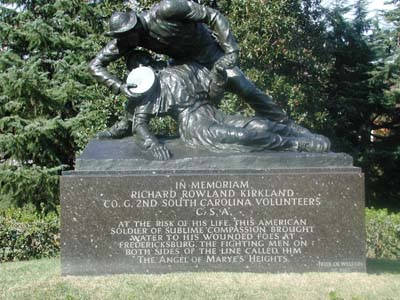 |
|
|
|
Наш сайт посвящён изучению истории и культуры Северной Америки XIX века: Техасской революции и Республике Техас (1836-1845 гг.), Американо-Мексиканской войне (1846-1848 гг.), войне Севера и Юга США (1861-1865 гг.), периоду Реконструкции Юга (1865-1877 гг.), освоению Дикого Запада (период между 1865-1890 гг., в который происходило заселение западных территорий штатов: Северная и Южная Дакота, Монтана, Канзас, Вайоминг, Небраска и Техас), и другим событиям на Североамериканском континенте. Будем рады если вы поможете нам в сборе материала по этой интересной и увлекательной теме. | | 18+
|
|
Richard Kirkland, The Angel of Marye's Heights
By MAC WYCKOFF

How many of you would try to save a friend knowing it might result in your own death?
Probably some of you would.
How many of you would try to save the life of an enemy knowing it might result in your own death?
Probably very few, if any, of you would take that risk.
Yet, that is exactly what Richard Rowland Kirkland did during the Battle of Fredericksburg. Both who he is and what he did are worth learning about.
Born in August 1843, he was the fifth son of Mary and John Kirkland. They lived in the rural community of Flat Rock in the Kershaw District, South Carolina.
A friend described him as a slender, but well-proportioned muscular man at 5â8", who weighed about 150 pounds. His photograph reveals a handsome young man with a mustache.
A good marksman, Kirkland excelled in riding a horse. His war letters reflect a religious young man of moderate education typical of the thousands of young men who went to war in 1861.
Despite his youth, Kirkland was eager to fight for his country. He enlisted before his older brothers and friends in Company E, 2nd South Carolina. After a year of service as a private, he switched to Company G to be with his friends and was soon promoted to sergeant.
By December of 1862, Kirkland had become a combat veteran, having seen action at 1st Manassas, Savage Station, Maryland Heights and Antietam. He had also witnessed the death of several of his best friends.
During the Battle of Fredericksburg on Dec. 13, 1862, Kirklandâs unit formed behind the Stone Wall at the base of Maryeâs Heights and helped slaughter the Union attackers. After a day of severe fighting, the scene shifted from severe fighting to tremendous suffering.
After dark on the 13th, doctors and soldiers began caring for the injured. The walking wounded made their way to the rear while those with disabling wounds remained on the field.
Daylight on the 14th revealed a ghastly scene to the Confederates behind the Stone Wall. About 8,000 Union soldiers had been shot in front of the wall and many of them remained where they had fallen. As hours went by without food, water or medical treatment, their suffering increased.
Nearby soldiers from both sides listened to the painful cries and pleas for help. While the suffering emotionally moved many, none dared face almost certain death to provide help.
At some point in the day, Kirkland could no longer bear listening to the pleas, so he walked over to the home of Martha Stevens. He went upstairs and told General Joseph Kershaw, his brigade commander, that he would like to try and help the wounded Union soldiers.
The surprised general at first refused the request, but he later relented.
Kirkland gathered all the canteens he could carry and filled them at the near by water well. Then, at extreme risk to himself, he ventured out to help the Federal soldiers. He carried water and warm clothing to the suffering Federal soldiers.
Kershaw anxiously watched Kirkland for 1 ¸ hours on his ãerrand of mercy, Christ-like mercy.ä
Kirkland went on to fight at Chancellorsville and Gettysburg. On Sept. 20, 1863, during the Battle of Chickamauga, Kirkland and two buddies got out in front as they charged up Snodgrass Hill.
Realizing their predicament, they turned to rejoin their unit. Kirkland lingered for a fatal moment to fire one more shot and was mortally wounded. His final words were, "Tell my pa, I died right."
His body was returned home for burial. Years later, a friend visited his grave and described the location as "one of the most sequestered, unfrequented, and inaccessible spots I ever saw."
In 1909, his remains were moved to Quaker Cemetery in Camden just a few paces from the grave of Gen. Kershaw.
In 1965, the magnificent statue sculpted by the famous artist Felix DeWeldon was unveiled in front of the Stone Wall in Fredericksburg where he had performed his humanitarian acts.
At a time we sorely need heroes, this young Southern boy set an admirable example of concern for his fellow human beings and extreme courage.
Источник: http://www.fredericksburg.com/CivilWar/Battle/kirkland.htm |
| Категория: Статьи на английском языке | Добавил: Wild_West (31.03.2012)
|
| Просмотров: 828
| Рейтинг: 0.0/0 |
Добавлять комментарии могут только зарегистрированные пользователи. [ Регистрация | Вход ] |
|
| Меню сайта |
|
 |
| Форма входа |
|
 |
| Категории раздела |
|
 |
| Поиск |
|
 |
| Наш опрос |
|
 |
| Статистика |
Онлайн всего: 1 Гостей: 1 Пользователей: 0 |
 |
Новые фото
|
|





